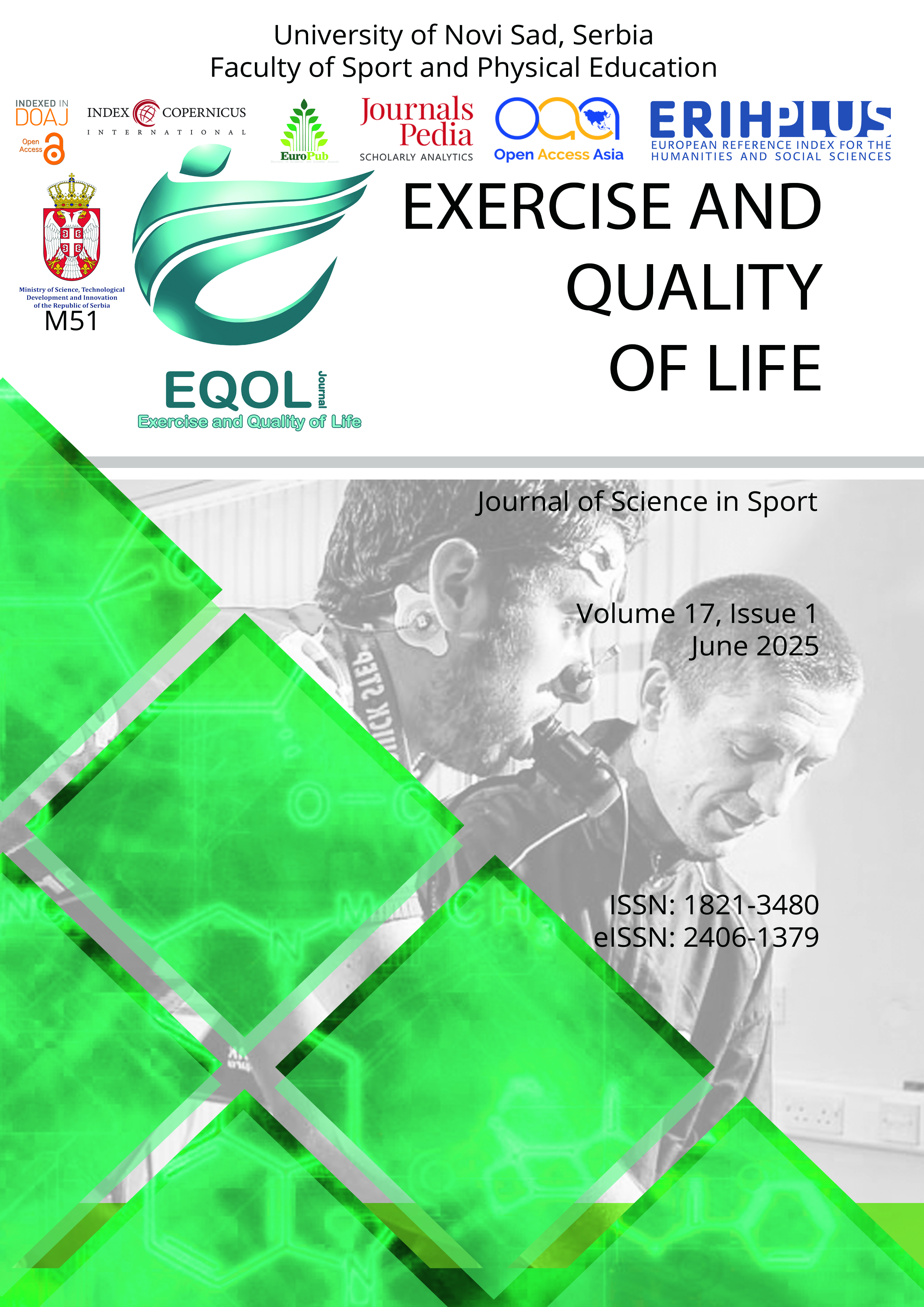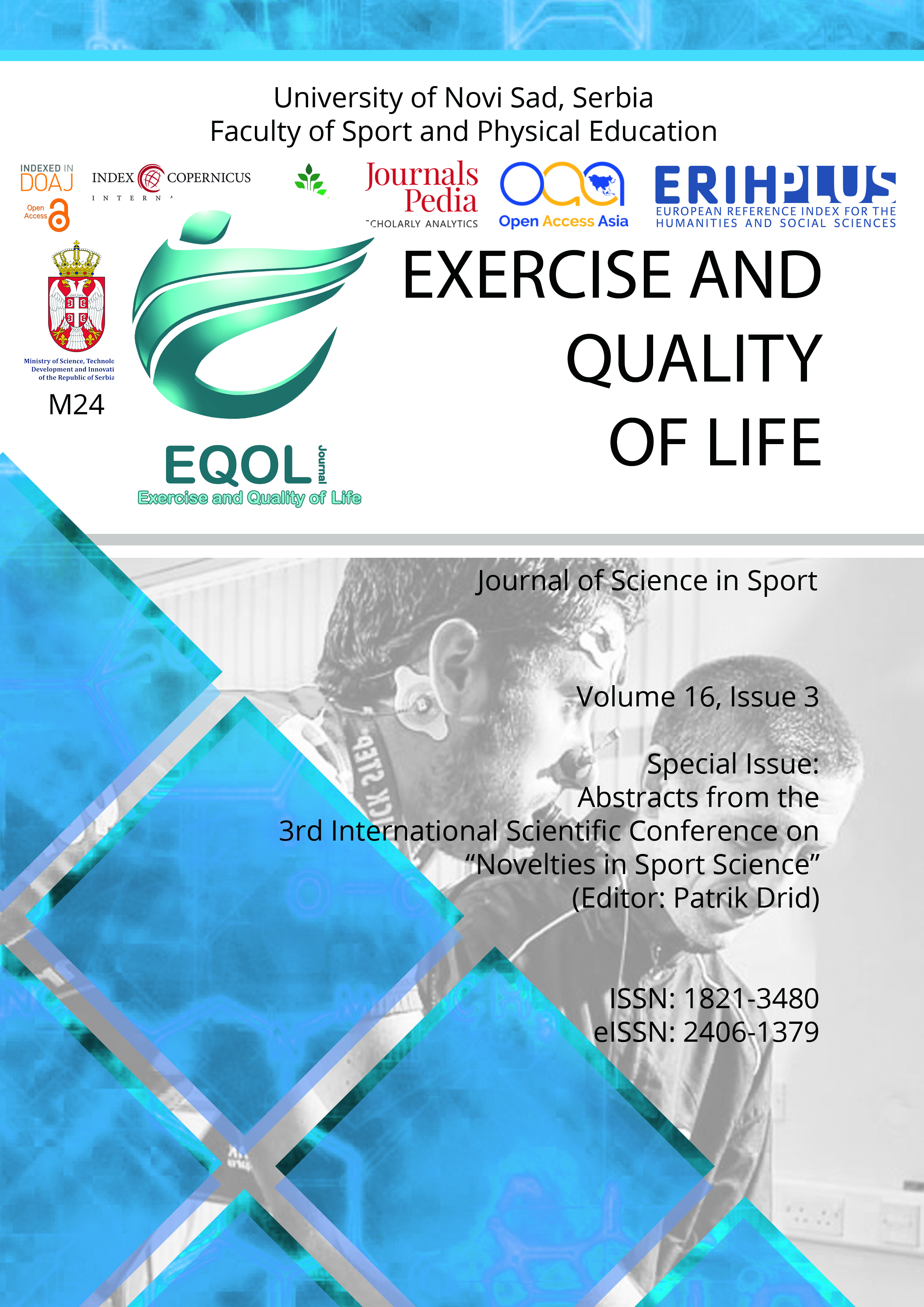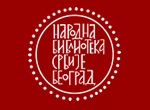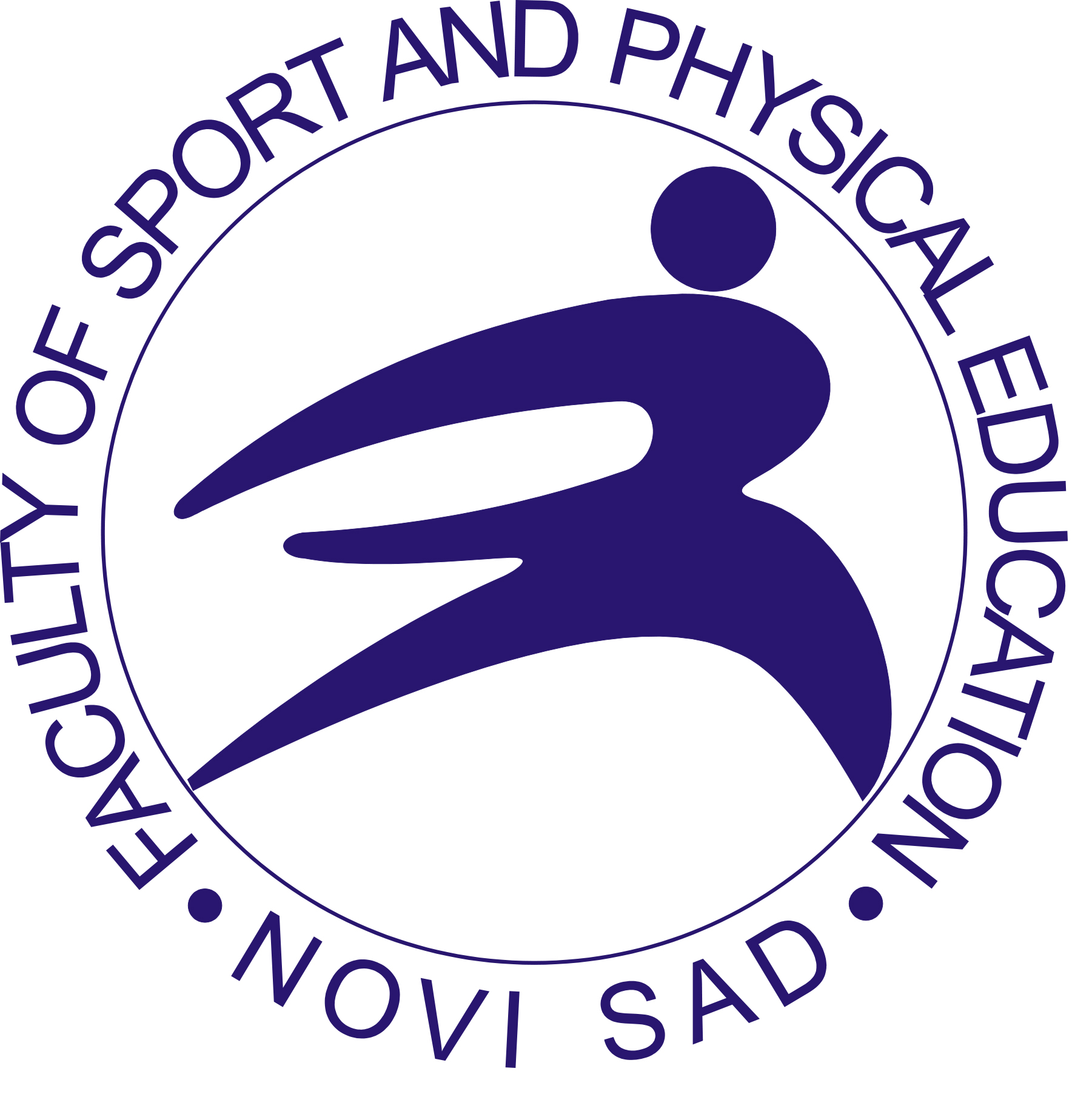Current issue

Volume 17, Issue 1, 2025
Online ISSN: 2406-1379
ISSN: 1821-3480
Volume 17 , Issue 1, (2025)
Published: 15.06.2025.
Open Access
All issues
Contents
11.12.2022.
Original scientific paper
Effects of CrossFit training program and traditional gym training on morphological characteristics of men
CrossFit is recognized as one of the fastest-growing high-intensity functional training modes in the world. The study aimed to compare the effects of the CrossFit training program and traditional gym training on anthropometric measurements in healthy, active men. The study sample consisted of 50 participants who were divided into two groups, 22 participants who practiced the CrossFit training program (CFT group; 28.64±2.04 years; body height 181.74±6.96 cm; body mass: 72.75±5.53 kg), and 28 participants who applied traditional gym training (GT group; 26.89±2.99 years; body height: 184.52±7.80 cm; body mass: 74.86±8.48 kg). A total of ten anthropometric measurements (Body height, Body mass, BMI, Subscapular, Abdominal and Triceps skinfolds, Chest, Forearm, Upper arm, and Thigh circumferences) were monitored before and after twelve weeks. The Shapiro-Wilk test was used to test the normality of distribution. The multivariate analysis covariance (MANCOVA) and analysis of covariance (ANCOVA) were used to analyze the data. The results of this study indicated that there were statistically significant differences between groups in the Circumference of the upper arm (p=0.02), Thigh circumference (p=0.00), Chest circumference (p=0.03), and Subscapular skinfold (p=0.00). The findings of this study demonstrated that healthy, active males who participated in the 12-week CrossFit training program improved their anthropometric measurements more than those who trained in the traditional gym training.
Ljubiša Kićanović, Bogdan Živanović, Mila Vukadinović Jurišić, Jelena Obradović
11.12.2022.
Preliminary report/Short communication
Moving beyond the physical: Exploring the holistic benefits of a therapy-based physical activity program for individuals with Parkinson’s disease
In individuals diagnosed with Parkinson’s Disease (PD), a chronic neurodegenerative disorder affecting movement and functionality, therapy-based physical activity (PA) that includes repetitive, quick motions benefits physical and cognitive functioning and can positively impact the disease course. Furthermore, the benefits of therapeutic PA participation may extend beyond physiological outcomes by positively influencing social and psychological well-being, thus increasing the overall quality of life (QoL). The current research examined a regional healthcare system-supported group therapeutic boxing/PA program for PD using a biopsychosocial lens to synthesize the holistic benefits of long-term program participation. Researchers conducted semi-structured focus group interviews with program participants (n = 18) and their caregivers (n = 7) to explore the perceived benefits of a combination boxing/PA program that included 30 minutes of boxing and 30 minutes of an alternate rotating PA 1-3 times per week. Results indicated a positive impact on participants’ and caregivers’ QoL by increasing socialization and empowerment and improving/maintaining physical function. These results demonstrate the importance of using a biopsychosocial approach in program design and evaluation of PA-based PD interventions. In addition to addressing PD-specific physical needs, PA programs should be constructed to include supportive social atmospheres and consider non-physical needs and overall QoL outcomes of patients and caregivers.
Kimberly S. Fasczewski, Nolasco R. Stevens, Hannah S. Michels, Jennifer S. Howard
15.06.0201.
Original scientific paper
Influence of maternal level of education and socioeconomic status on maternal knowledge of nutrition, physical activity and children’s bodyweight of Nigerian school pupils
This study investigated the influence of maternal level of education and socioeconomic status on maternal knowledge of nutrition, physical activity, and children’s body weight of Nigerian school pupils. A total of four hundred and twelve (412) primary school pupils participated in this study. A structured questionnaire was used to assess the maternal level of education, material’s knowledge of nutrition, and physical activities. Body height and body weight were measured with a wall-mounted stadiometer in meters and a bathroom weighing scale in kg, respectively. The children’s body weight was determined using the formula weight (kg)/height (m2). The children were then categorized into different classes of body mass index based on the recommendation of Centers for Diseases Control and Prevention (2015), which is age and sex-specific for children and teens from two years old through 20 years. The differences in maternal educational qualification and children’s bodyweights were analyzed using the independent sample t-test. However, the influence of maternal SES on maternal knowledge of nutrition, physical activities, and children’s body weights were analyzed using ANOVA. Statistical significance was accepted for a p-value of <0.05. The outcome of this study showed that the educational qualification of mothers had a significant (p<0.05) influence on children’s bodyweights. It was also observed from this study that the maternal SES significantly (p<0.05) influenced maternal nutritional knowledge, maternal knowledge of physical activities, and children’s bodyweights. This study therefore concluded that the maternal level of education and SES do influence maternal knowledge of nutrition and physical activity as well as children’s bodyweights.
Adebisi I. Hammed, Suleiman O. Usman, Onyemechi Ezekiel, Joy C. Duru, Oluwaseun J. Oladimeji, Ogolo Jirho
15.06.2021.
Original scientific paper
Mental toughness and performance strategies of martial artists in practice and competition
Abstract This study’s objective was to analyze the relationship between mental toughness and martial artists’ performance strategies. Two hundred athletes (male: 105, female: 95) with an age range of 18-36 years (mean:25.12, s=4.96) who competed at university to the national standard of martial arts participated in this study. Participants answered mental toughness questionnaires and performance strategies inventory. The Pearson correlation results showed a positive and significant relationship between mental toughness and automaticity, goal-setting, imagery, self-talk, and emotional control, and a negative and significant relationship between mental toughness and attentional control in practice. Furthermore, there is a positive and significant relationship between mental toughness and activation, relaxation, self-talk, imagery, goal-setting, and emotional control in the competition. The multiple linear regression analysis results showed that goal-setting and imagery in practice and competition, self-talk in practice, and relaxation in the competition could predict mental toughness. In analyzing the subscales of mental toughness, it was concluded that tough emotions could be loaded on eight subscales of performance strategies. In the Independent-Sample T-Test, the significant differences related to gender were that men reported higher levels of self-talk (t=3.24, p<0.001), automaticity (t=2.76, p<0.006), goal-setting (t=2.63, p<0.009), imagery (t=2.18, p<0.03) and relaxation (t=2.17, p<0.03) than women.
Atefeh Beheshti, Hassan Gharayagh Zandi, Zahra Fathirezaie, Fatemeh Heidari
15.12.2021.
Original scientific paper
Psychometric properties of Bull’s Mental Skills Questionnaire in a Turkish population
The purpose of this research was to examine the reliability and validity of Bull’s Mental Skills Questionnaire (BMSQ), measuring seven psychological skills resulting in a total scale score, within Turkey. The sample consisting of 163 males and 131 females, totaling 294 athletes, completed the 28 item BMSQ. Exploratory factor analysis (EFA) and confirmatory factor analysis (CFA) were undertaken. EFA results yielded a satisfactory seven-factor solution, the same as the English version. Cronbach alpha (α) reliability indices were as follows: concentration ability (0.71), anxiety and worry management (0.63), relaxation ability (0.69), imagery ability (0.73), self-confidence (0.72), motivation (0.64) and mental preparation (0.52). The BMSQ explained 62% of the total variance. Moreover, model fit indices calculated during CFA for the 28 item and 7 sub-dimensions model of BMSQ indicated an acceptable fit [Chi-Square (ꭓ²)=541.2, df=328, ꭓ²/df=1.65, Root Mean Square Error Approximation (RMSEA)=0.05, Comparative Fit Index (CFI)=0.95, Goodness of Fit Index (GFI)=0.90, Normed Fit Index (NFI)=0.89, and Non Normed Fit Index (NNFI)=0.90]. Thus, the original 7-factor solution was supported with the data collected from Turkish participants. Results demonstrated that the BMSQ is a valid and reliable instrument for the Turkish population.
Bülent O. Miçooğullari, David J. Edwards, Rıdvan Ekmekçi
15.12.2021.
Original scientific paper
Flowart, a physical activity at the level of hypermodernity, even hypomodernity
Our current hypermodern era, as described by many authors, imposes frenzied rhythms of life on individuals exacerbated by new communication technologies. In this incessant tumult, it has become more and more difficult for humans to take time for themselves or even a moment to reflect on their daily lives. It therefore seems necessary for some to indulge in more contemplative and meditative leisure and sporting activities that reconnect with the principles of otium and thus fall into a form of hypomodernity. It is in this reflective context that this study was conducted to interview seven flowart practitioners using a qualitative approach. Halfway between artistic practice and physical activity, flowart seems to allow these individuals to reconnect with a rhythm of life that is more biological than digital. These participants see a way to slow down the frenzy of their daily life in this practice while becoming more aware of their place in a cosmic and metaphysical whole.
Romain Roult, Frédéric Martineau
15.06.2021.
Original scientific paper
Relationship between cognitive abilities and manual coordination and balance in preschool children
Background: The purpose of this research was to investigate the relationship between cognitive abilities and manual coordination and balance in preschool children. Methods: The sample consisted of 41 preschool children aged 6.4±0.8 on average, of both sexes (30 boys and 11 girls). On top of their regular preschool activities, the children attended a school of sports for preschool children - multisport activities and exercises, twice a week. The sample of measuring instruments comprised 4 motor tests (One-leg stand test, Mann’s test, Finger to nose, Front raises) and 2 cognitive tests (Raven's Colored Progressive Matrices, Cognitive Assessment System). Data was analyzed by applying Linear and Binary logistic regression analysis. Results: Based on the results of the research, one may conclude that there is a statistically significant relation between cognitive abilities and manual coordination in the tested sample of preschool children. The defined predictor system, which consisted of cognitive tests, showed a significant relationship with the hand coordination test, which was assessed by the Finger to Nose test with the eyes closed. A significant contribution to the established relation was given by the G factor estimated by Raven's colored progressive matrices. Conclusions: Physical activities contribute to the development of motor skills and thus to the development of some cognitive abilities in children, which is of great importance for their further development.
Filip Sadri, Ivo Sadri, Željko Krneta, Jovana Trbojević Jocić, Maja Batez
15.12.2021.
Original scientific paper
Level of physical activity and quality of life associated with health in Paraguay adults
Studies have shown that the performance of scheduled physical activity is positively related to a higher quality of life related to health. The objective of this study was to evaluate the level of physical activity according to the quality of life in the adult population of Paraguay in the period from November to December 2020. A descriptive, analytical cross-sectional design study, which included 211 adults of both sexes. Sociodemographic data such as age, sex and origin were collected, as well as data on physical activity (IPAQ/METS questionnaire) and quality of life (EuroQol-5D questionnaire). The predominant sex was female (89%), 53.5% resided in Gran Asunción and the average age was 34.6±10.6. The level of physical activity was mostly moderate (36.5%). The quality of life index was 0.67±0.15 and the perception of health was 79.12±18.35. Within the dimensions of quality of life, it was observed that 23% had moderate pain or discomfort and that 33% had moderate depression or anxiety. Significant differences were found between the level of physical activity and the quality of life index and the perception of health. The level of physical activity is a determinant of health-related quality of life, the greater the intensity of physical activity, the better the quality and perception of health indices in adults.
Eliana R. Meza-Miranda, Jazmín Giménez
15.12.2021.
Original scientific paper
Effectiveness of exercise training program on postural control and quality of life in middle-aged men with unilateral lower limb amputation
This study aimed to investigate whether the exercise-based amputee rehabilitation program improves postural control and quality of life in people with unilateral transtibial amputation (TTA). Twenty middle-aged men (48.4±3.8 y) with lower limb amputation, in a randomized-controlled longitudinal design, volunteered to participate in the study and were divided into experimental (EXP, n=10) and control (CON, n=10) groups. Before and after 8 weeks of the exercise training program, postural control performance, using one-leg standing (OLS) and Y-balance tests, was measured. The quality of life was also assessed before and after 8 weeks training period using standard questionnaires. Group x time interactions were observed for the EXP group in OLS and Y-balance tests and quality of life scores in comparison to pre- training values and the CON group (p<0.05). People with unilateral TTA who received exercise-based amputee rehabilitation program demonstrated significant improvement in balance performance with significant effects on quality of life.
Masoud Kashfi, Iman Khakroo Abkenar, Ali Fakourian, Giovanni Lombardi
15.12.2021.
Review scientific paper
The efficiency of proprioceptive training in preventing injuries to team athletes: A systematic review
The aim of this systematic review was to evaluate the effectiveness of proprioceptive training in the prevention of lower extremity injuries, especially the ankle and knee joint, in team athletes. PRISMA recommendations were applied for this research. PubMed, ScienceDirect, and BioMed Central were used to identify relevant studies. The methodological quality of studies was assessed using the Physiotherapy Evidence Database-PEDro scale. Only 7 research met the eligibility criteria, and their outcomes were presented. Proprioceptive training has been shown to be very effective in preventing ankle injuries, especially in recurrent ankle sprains. However, in 3 of 4 studies lacked the effects of proprioceptive training in the prevention of knee and ACL injuries. Based on the results of the analyzed research, I can conclude that proprioceptive training is a very effective training tool in the prevention of ankle sprains in the population of team athletes, but proprioceptive training is not sufficient as the only training component in preventing knee injuries.
Marko Manojlović





























